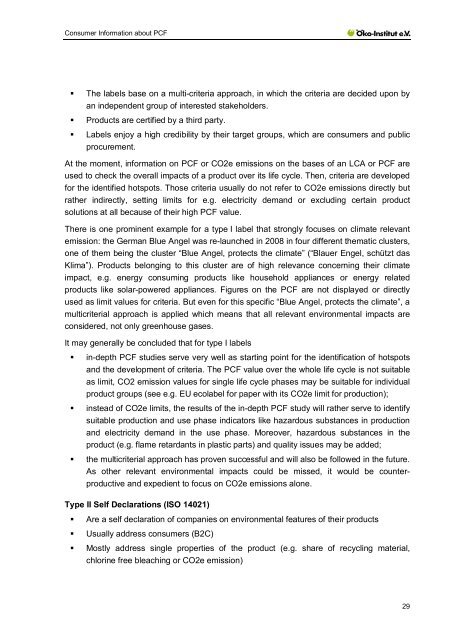Requirements on Consumer Information about Product ... - ANEC
Requirements on Consumer Information about Product ... - ANEC
Requirements on Consumer Information about Product ... - ANEC
You also want an ePaper? Increase the reach of your titles
YUMPU automatically turns print PDFs into web optimized ePapers that Google loves.
C<strong>on</strong>sumer Informati<strong>on</strong> <strong>about</strong> PCF<br />
• The labels base <strong>on</strong> a multi-criteria approach, in which the criteria are decided up<strong>on</strong> by<br />
an independent group of interested stakeholders.<br />
• <strong>Product</strong>s are certified by a third party.<br />
• Labels enjoy a high credibility by their target groups, which are c<strong>on</strong>sumers and public<br />
procurement.<br />
At the moment, informati<strong>on</strong> <strong>on</strong> PCF or CO2e emissi<strong>on</strong>s <strong>on</strong> the bases of an LCA or PCF are<br />
used to check the overall impacts of a product over its life cycle. Then, criteria are developed<br />
for the identified hotspots. Those criteria usually do not refer to CO2e emissi<strong>on</strong>s directly but<br />
rather indirectly, setting limits for e.g. electricity demand or excluding certain product<br />
soluti<strong>on</strong>s at all because of their high PCF value.<br />
There is <strong>on</strong>e prominent example for a type I label that str<strong>on</strong>gly focuses <strong>on</strong> climate relevant<br />
emissi<strong>on</strong>: the German Blue Angel was re-launched in 2008 in four different thematic clusters,<br />
<strong>on</strong>e of them being the cluster “Blue Angel, protects the climate” (“Blauer Engel, schützt das<br />
Klima”). <strong>Product</strong>s bel<strong>on</strong>ging to this cluster are of high relevance c<strong>on</strong>cerning their climate<br />
impact, e.g. energy c<strong>on</strong>suming products like household appliances or energy related<br />
products like solar-powered appliances. Figures <strong>on</strong> the PCF are not displayed or directly<br />
used as limit values for criteria. But even for this specific “Blue Angel, protects the climate”, a<br />
multicriterial approach is applied which means that all relevant envir<strong>on</strong>mental impacts are<br />
c<strong>on</strong>sidered, not <strong>on</strong>ly greenhouse gases.<br />
It may generally be c<strong>on</strong>cluded that for type I labels<br />
• in-depth PCF studies serve very well as starting point for the identificati<strong>on</strong> of hotspots<br />
and the development of criteria. The PCF value over the whole life cycle is not suitable<br />
as limit, CO2 emissi<strong>on</strong> values for single life cycle phases may be suitable for individual<br />
product groups (see e.g. EU ecolabel for paper with its CO2e limit for producti<strong>on</strong>);<br />
• instead of CO2e limits, the results of the in-depth PCF study will rather serve to identify<br />
suitable producti<strong>on</strong> and use phase indicators like hazardous substances in producti<strong>on</strong><br />
and electricity demand in the use phase. Moreover, hazardous substances in the<br />
product (e.g. flame retardants in plastic parts) and quality issues may be added;<br />
• the multicriterial approach has proven successful and will also be followed in the future.<br />
As other relevant envir<strong>on</strong>mental impacts could be missed, it would be counterproductive<br />
and expedient to focus <strong>on</strong> CO2e emissi<strong>on</strong>s al<strong>on</strong>e.<br />
Type II Self Declarati<strong>on</strong>s (ISO 14021)<br />
• Are a self declarati<strong>on</strong> of companies <strong>on</strong> envir<strong>on</strong>mental features of their products<br />
• Usually address c<strong>on</strong>sumers (B2C)<br />
• Mostly address single properties of the product (e.g. share of recycling material,<br />
chlorine free bleaching or CO2e emissi<strong>on</strong>)<br />
29
















